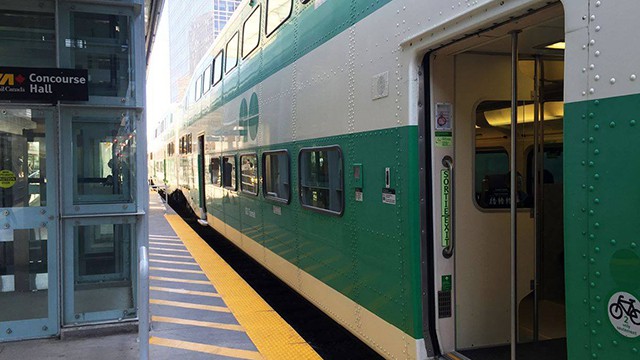Huge Changes Coming to GO Train Service in Mississauga and Surrounding Cities
Published March 26, 2018 at 7:51 pm

While the future of Ontario’s Liberal government is uncertain, the province has not dropped the ball on its ambitious transit plans.
Recently, the province announced that it’s taking “a major step forward” in bringing more all-day, two-way GO train service to the Greater Toronto and Hamilton Area (GTHA), with new stations and upgrades across the GO network.
“Work is well underway to build a better, integrated and seamless transit network across the GTHA,” says Kathryn McGarry, Minister of Transportation. “Today’s announcement is a major milestone in the delivery of all-day two-way electrified train service, more station stops and more service to get commuters where they need to be sooner.”
As for what’s happening in Mississauga specifically, the province recently announced that more late-night and weekend train trips along the Lakeshore GO corridor are being added by Metrolinx.
“Regular, reliable public transit is essential to helping people access the jobs, services and opportunities that help to provide a high quality of life,” said Minister of Transportation Kathryn McGarry earlier this month. “More consistent 30-minute service on the Lakeshore lines between Oakville and Oshawa brings us closer to delivering on our promise of 15-minute service–all day, every day.”
New weekend morning trips and daily late-night trips for riders on the Lakeshore West and East lines begin April 7.
Ontario has already increased GO train service by more than 70 per cent, adding approximately 800 more train trips every week across the GO network than there were in 2013.
In the coming weeks, the province will launch the process to design and build six new GO stations and six new Toronto SmartTrack stations, as well as upgrades and improvements to over 20 existing GO stations, including major renovations to station buildings, new bus loops, digital signage, and other enhancements.
The province says it will also move forward with the procurement of new maintenance facilities, trains, tracks, and other infrastructure necessary to increase GO service.
The Lakeshore West line is slated to receive a number of improvements between now and 2025.
Upgrades to the Lakeshore West GO corridor include: Track improvements and other work to enable increased service at Exhibition Station; Mimico Station rehabilitation; Long Branch Station improvements, including accessibility enhancements; upgrades to enable increased service at Clarkson and Bronte stations; grade separations at Kerr St. and Burloak Dr.; replacement of the Drury Lane pedestrian bridge; further expansion of the Lewis Road layover facility.
Ontario’s GO Regional Express Railway (RER) program is the largest rail project in Canada. The province says weekly trips across the entire GO rail network will grow from about 1,100 in 2013 to nearly 6,000 by 2025, with more all-day, two-way, 15-minute electrified GO service for commuters and families across the region.
Ontario is investing $21.3 billion to transform GO Transit from a commuter transit service to a regional rapid transit system.
The province will issue a Request for Qualifications (RFQ) to select a proponent to design, build, finance, operate and maintain GO RER. This contract will integrate rail operations and maintenance with the infrastructure and vehicle upgrades required to deliver electrified rail service on the GO rail network.
Ontario will also issue RFQs for six new GO stations, 22 existing GO stations, and six new Toronto SmartTrack stations. GO RER, will provide the foundation for the SmartTrack project, which includes integrated rail service on Stouffville, Lakeshore East and Kitchener GO rail corridors, and the Eglinton West Light Rail Transit (LRT) extension between Mount Dennis and Renforth Gateway.
GO RER includes more than 400 separate projects across more than 40 municipalities, and is the largest single investment in rapid transit in Canada.
Since 2013, Ontario has built four new GO stations, renovated 10 existing GO stations, and added approximately 7,000 new GO station parking spots. The province has also purchased 264 new GO buses, 150 new GO train coaches, and 10 new GO train locomotives.
“This is a momentous time as we get set to quadruple weekly train trips, electrify the network and connect the people of our region to where they want to go better, faster and easier,” says Phil Verster, president and CEO, Metrolinx. “We are eager to engage with a field of world-class partners for this new chapter of unprecedented transit building that will set our region up for success for generations to come.”
INsauga's Editorial Standards and Policies